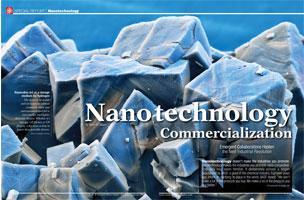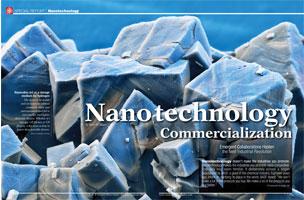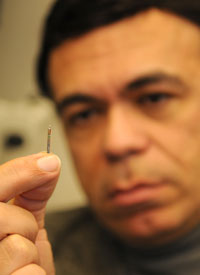
 Nanotechnology doesn’t make the industries you promote. Nanotechnology makes the industries you promote more competitive.
Nanotechnology doesn’t make the industries you promote. Nanotechnology makes the industries you promote more competitive.
This idea may seem familiar. It deliberately echoes a slogan popularized by BASF, a giant of the chemical industry. Eighteen years ago, intent on clarifying its place in the world, BASF stated, “We don’t make a lot of the products you buy. We make a lot of the products you buy better.”
Recalling this venerable slogan is appropriate for two reasons. First, nanotechnology, like the chemical industry, has myriad (if indirect) applications. Second, nanotechnology is driving a new industrial revolution that elaborates on features of the second, or chemical, revolution.
The first industrial revolution, which exploited the potential of iron and coal, was centered in Great Britain. To this day, fairly or not, this era is associated with freewheeling individual initiative and the so-called animal spirits of capitalism – all the usual tenets of laissez faire philosophy.
The second industrial revolution elaborated on the first. Instead of simply producing iron in quantity, specialty steels were developed. And coal was no longer used as mere fuel. Coal derivatives led to dyes, then pharmaceuticals.
These developments were especially conspicuous in Germany, which created institutions that deliberately linked theoretical science and technological innovation. According to one historian, “German chemical and electrical companies pioneered the creation of industrial research laboratories staffed by university-trained chemists and physicists, whose investigations and experiments were conceived, not as a sort of emergency auxiliary to normal operations, but as an integral and permanent part of the enterprise.”1
The distinctions between the first and second industrial revolutions are easily overdrawn. Coordinated action was not absent from the first. And neither was the drive for individual gain absent from the second. Nevertheless, the example of the second industrial revolution seems especially apt today. Then, the coordination of scientific and technological resources was of central importance. And so it is today, on the eve of the nanotechnology revolution.  In truth, research and development never ceased to be important, although it did fade from the popular imagination. In the 1980s, there was frustration over the apparent disconnect between research prowess and commercial success. (The United States could claim the former, but perceived the latter shifting to Japan.) Then, through the 1990s, personal computing, the Internet, and the Web seemed to be the creation of lone geeks realizing an updated version of the old Horatio Alger dream, toiling in their garages one day, running multinational corporations the next. Forgotten was the foundational work carried out by academic researchers, the Defense Advanced Research Projects Administration (DARPA), and the European Organization for Nuclear Research (CERN).
In truth, research and development never ceased to be important, although it did fade from the popular imagination. In the 1980s, there was frustration over the apparent disconnect between research prowess and commercial success. (The United States could claim the former, but perceived the latter shifting to Japan.) Then, through the 1990s, personal computing, the Internet, and the Web seemed to be the creation of lone geeks realizing an updated version of the old Horatio Alger dream, toiling in their garages one day, running multinational corporations the next. Forgotten was the foundational work carried out by academic researchers, the Defense Advanced Research Projects Administration (DARPA), and the European Organization for Nuclear Research (CERN).
Nanotechnology may yet spawn a few Horatio Alger stories of its own. Until recently, it was characterized by a great deal of “push” from government-funded research, and relatively little entrepreneurial “pull.” This balance, however, has been shifting. At every level – national, regional, state and local – initiatives have been launched to derive economic benefits from nanotechnology.
Many of these initiatives cultivate communities of innovation, creating ties between researchers, corporate interests, entrepreneurs and venture capitalists. It is hoped that a sufficient density of ties will activate the potential, otherwise latent, of existing resources.
Curiously, this approach complements the nature of nanotechnology much like the creation of research establishments in the 1800s complemented the nature of chemistry. Chemistry deals with atoms and molecules in bulk, regimenting their combinations, reorientations, and separations – just the thing to stimulate top-down thinking and a linear conception of product development.
Nanotechnology also deals with atoms and molecules, but not in bulk. Instead, they are seen as interacting parts of a system. And this system has properties of its own. These may arise from atomic and molecular interactions so subtle they have only recently been subject to careful investigation. They include “weak” interactions such as hydrogen bonding, electrostatic dipoles, van der Waals forces, various surface forces, and electro-fluidic forces.2
These interactions have seldom been exploited, at least in human-made systems. But the fine organization of matter at the nano scale is essential to the exquisite functioning of living systems. This encompasses gene transcription and replication, cell division, the functions of membrane-bound proteins and much more. Capturing just a little of this subtlety in human-made systems opens new frontiers in industry.
Traditional chemistry puts atoms and molecules on the march. Nanotechnology has them dance. And nanotechnology-led economic development choreographs a dance of public and private resources – the animal spirits of the market, the intellect of the research establishment, and the creative ferment of communities of innovation.
National Nanotechnology Initiative  Established in 2001, the National Nanotechnology Initiative (NNI) coordinates federal nanotechnology research and development. Activities coordinated by the NNI have been funded with increasing generosity, despite a tightening fiscal environment. In 2001, its annual budget was $464 million. In 2009, it grew to $1.5 billion.
Established in 2001, the National Nanotechnology Initiative (NNI) coordinates federal nanotechnology research and development. Activities coordinated by the NNI have been funded with increasing generosity, despite a tightening fiscal environment. In 2001, its annual budget was $464 million. In 2009, it grew to $1.5 billion.
The NNI coordinates the nanotechnology-related activities of multiple agencies – 25 at present – establishing shared goals, priorities and strategies. The reported NNI budget represents the sum of the nanotechnology-related budgets of its member agencies. Although the NNI does not fund research, it informs and influences the federal budget and planning processes through its member agencies, which include the Department of Defense, the National Science Foundation, the Department of Energy, the National Institutes of Health, and the National Institute of Standards and Technology.
NNI-participating agencies have developed an extensive network of research and education centers. Over 60 centers are located at various sites across the country. Many such centers are designated as user facilities. These facilities serve the needs of scientists at the national laboratories, but they are also available to researchers from academia and the private sector.
Beyond the federal program, the NNI works with other governmental and nongovernmental organizations interested in developing nanotechnology, particularly its commercial applications. For example, several regional, state and local governments have started building nanotechnology-based clusters. These are concentrations of universities, investors and interrelated businesses with common manufacturing processes, customers and suppliers.
The NNI maintains that there are opportunities for leveraging NNI investments in every region. It has announced that it will help local groups seize these opportunities by facilitating communication between local nanotechnology initiatives and identifying barriers to commercialization.3
Regional and State Initiatives
“Nanotechnology is usually seen as a worldwide or national enterprise, with the U.S. government alone investing $6.8 billion over the last decade. But what some describe as ‘The Next Industrial Revolution’ is actually taking place at a local and state level.” This comment was attributed to David Rejeski, director of the Project on Emerging Nanotechnologies, a partnership between the Woodrow Wilson International Center for Scholars and the Pew Charitable Trusts.
The occasion for Rejeski’s comment was the announcement of an interactive map depicting and ranking cities and states by numbers of companies, nanotechnology academic and government research centers, organizations, and business sectors. This map is just one of many efforts to establish nanotechnology metrics and track progress in nanotechnology development.
Suggestions for appropriate nanotechnology metrics include number of research grants, number of patents, number of nanotechnology-related companies and investment totals. Although it is seldom clear how these composite metrics are weighted in any particular organization’s ranking, they may still lead to useful observations.
For example, the interactive map indicates that nanotechnology companies are working in three main sectors: materials, medicine and health, and tools and instruments. In addition, it suggests that the leading nanotechnology states are California, Massachusetts, New York and Texas. However, the map also reveals that 47 of 50 states contain at least one nanotechnology-related company, university, government laboratory or organization, showing that nanotechnology activity is occurring throughout the United States.4
Developmental Stages
Because nanotechnology is an enabling technology with applications in a variety of industries, business leaders and economic development authorities tend to pursue different nanotechnology priorities. For example, a region already prominent in electrical components will investigate ways nanotechnology can sustain its leadership in that field. But whatever industries a region hopes to strengthen or attract, it will try to progress from stage-to-stage along a developmental spectrum.
Stage 1: Regions try to build awareness and enthusiasm for nanotechnology. Associations are formed, new conference series are organized, studies are commissioned, and funds are raised to support nanotechnology in the area’s research and education institutions. In addition, interested parties may lobby for greater federal support, perhaps through expansions of existing government facilities.
Stage 2: Attempts to facilitate collaboration become more targeted. Instead of general-purpose interest groups, industry-specific consortiums may be organized. Task forces, public-private partnerships and strategic alliances are all designed to encourage more substantive industry participation.
Stage 3: State agencies are tasked with administering programs and implementing policies related to nanotechnology. These policies may address technology transfer, industry recruitment, incubation of innovative start-up businesses, innovation or enterprise zones, and workforce development.  State-by-state surveys suggest that most states have progressed at least as far as Stage 1, a good number have progressed to Stage 2, and a few have reached (or are approaching) Stage 3.
State-by-state surveys suggest that most states have progressed at least as far as Stage 1, a good number have progressed to Stage 2, and a few have reached (or are approaching) Stage 3.
An example of a Stage 1 state is Arizona, which is home to the Arizona Nanotechnology Cluster, a not-for-profit organization formed in January 2003. Its membership includes an active group of interested engineers (electrical, mechanical and chemical), scientists (medical and materials), and businesspeople from both industry and academia.
The mission of the Arizona Nanotechnology Cluster is to:
• Network nanotechnology, semiconductor and microelectronics specialists.
• Educate the public about nanotechnology and related issues.
• Create a “voice” for the nanotechnology industry at local, state and national levels.
• Engage in proactive efforts to locate federal nanotechnology laboratories and infrastructure support in Arizona.
A good example of Stage 2 development consists of a region rather than a state. This region, which covers Pennsylvania, New Jersey and Delaware, is represented by the Mid-Atlantic Nanotechnology Alliance (MANA). In an exhaustive study carried out with the Battelle Memorial Institute, MANA completed an inventory of academic and commercial nanotechnology resources in the region.
MANA detailed how these resources were crucial to selected industrial sectors. For example, MANA determined that in the industrial electronics sector, which accounts for over 35,000 jobs in the region, 75 percent of its sales revenue would involve products incorporating nanotechnology. For medical instruments and equipment, which accounts for over 29,000 jobs, the figure was 30 percent. For pharmaceuticals, which accounts for nearly 62,000 jobs, the figure was 23 percent.
MANA has identified several priorities, including the development of strategic alliances in nano catalysis-driven energy applications, bio-nano applications, and next-generation optoelectronics. Other strategic alliances concern not specific industry sectors, but rather general commercialization needs – access to advanced instrumentation, rapid prototyping facilities, and the development of health and safety regulations.
An example of Stage 3 development is New York State. It has built an extensive nanotechnology infrastructure. And it has aggressively pursued investment in chip fabrication – the sector in which the application of nanotechnology is most advanced.
In July 2008, Governor David A. Paterson announced new investments by IBM and New York State intended to create up to 1,000 new high-tech jobs. New York State will provide a total of $140 million in economic development grants, leveraging more than a 10-to-1 private investment of $1.5 billion from IBM. The investment will support the nanotechnology chip computer activities of IBM and upgrade related state resources.
1 McNeil, W. 1963. Rise of the West: A History of the Human Community. University of Chicago Press.
2 Roco, M.C. 2007. National Nanotechnology Initiative —Past, Present, Future. Handbook on Nanoscience, Engineering, and Technology. 2nd edition. Taylor and Francis.
3 See National Nanotechnology Initiative: http://www.nano.gov/html/about/funding.html
4 See Mapping the New U.S. NanoMetro Economy: http://www.nanotechproject.org/news/archive/mapping_new_us_nanometro_economy
